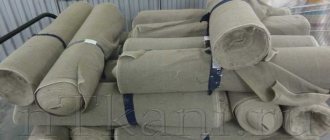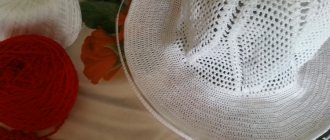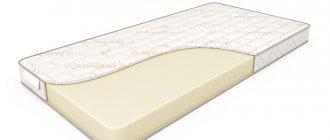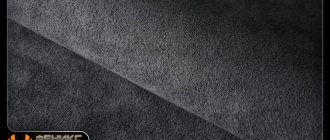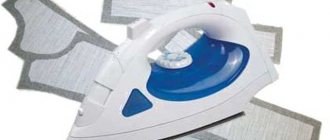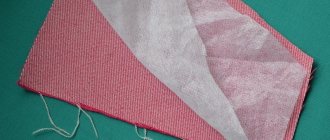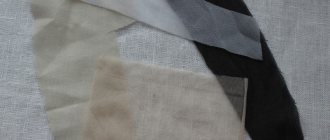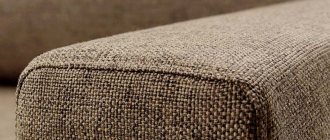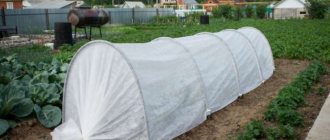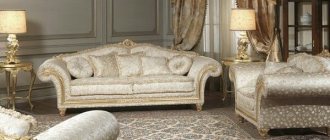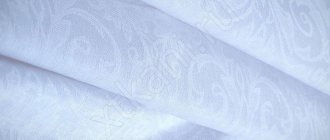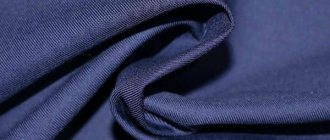Dublerin, what is it and how to use the properties of dublerin in sewing? Dublerin is classified as an adhesive lining material. The very name of the fabric - “dublerin” - indicates that the material is used to duplicate and strengthen certain parts of clothing and more. The use of dublerin gives volume and shape to clothes. Products reinforced with dublerin become more durable, wrinkle less and are not deformed. You can use dublerin with almost all fabrics.
Where is dublerin most often used? Of course, in those places of clothing that are subject to the greatest load, to increase the wear resistance and rigidity of clothing parts.
Dublerin is used to give shape to clothing parts, for example, to give a certain shape to collars. To do this, the neck is treated with a duplicate facing. Dublerin is widely used in children's clothing due to the fact that it is an environmentally friendly material. Most often, the standard colors of the material are found - white, gray, black, however, even such a small variety is enough for its widespread use.
Types of dublerin
Dublerin, what is it and what is it used for?
Dublerin cushioning material can be of several types depending on the scope of its application - with double-sided sizing or without it at all, etc. Sizing is a thin layer of glue applied to the material and dried in a special way. By exposing the adhesive layer to water or high temperatures, it becomes liquid and securely adheres the cushioning material to the product.
The strength of the duplicated fabric depends on its composition, the amount of glue, etc.
There are 3 types of dublerin:
- Fabric – a material made from compacted fabric. Compacted fabric coupled with an adhesive base makes this type of dublerin the most reliable. Fabric dublerin is used for sewing hats, shoes, bags, fur or leather products.
- Knitted pile is a less rigid, but rather dense lining material used for sewing outerwear. Pile dublerin is also used for sewing soft toys. This type of dublerin stretches well, but only in one direction, which is worth considering when sewing clothes.
- Elastic dublerin (knitted) is a pliable material that easily stretches in any direction. Used for sewing skirts, dresses, blouses, shirts, trousers, etc. Retains its shape perfectly even with frequent wear and numerous washes.
What purposes can this fabric be used for?
Dublerin is used when sewing clothes:
For strengthening the sides of coats, jackets, jackets, jackets
Dense cotton pads with a continuous adhesive shell are used to stiffen collars, trims, and shirt cuffs.
Gauze with dot coating is used for sewing cotton blouses
For sealing belts and dress corsets
For shaping hats
Clothes are repaired using knitted dublerin. Rigid fabric materials are used to strengthen:
Bags
Fabric books
Soft toy parts
Lambrequins for curtains
Shoes
How to glue dublerin
How to use adhesive doublerin when sewing clothes correctly?
Choose exactly the type of dublerin that suits your product:
- Before using dublerin, determine the adhesive side. To do this, touch the fabric on each side; the rough side will be the adhesive side. It is this that needs to be applied to the wrong side of the main fabric.
- Turn on the iron to the “wool” or “synthetic” mode without steam.
- Next, place the dublerin on the product with the adhesive side down, spray the fabric with water using a spray bottle.
- Using a heated iron, iron the fabric on top with a little force. It is important to press the iron against the fabric for a few seconds, and not to move it over the surface of the dublerin.
- Leave the glued lining material to cool and fix the glue.
How to use doublerin adhesive? Try gluing dublerin onto unnecessary scraps of fabric first to determine the most optimal iron temperature.
Benefits of doublerin
The main advantages of dublerin are that it practically does not tear, drapes well, and almost does not peel off.
An important advantage of this cushioning material is the variety of dublerin in terms of density, types of adhesive application, area of application, etc. Dublerin belongs to a whole group of fabrics, which includes various cobwebs, mesh, fleece - thin cushioning materials with glue applied to both sides.
Spandbond, another version of dubbing, is a non-adhesive non-woven material, which, due to its strength and density, is used for duplicating bags, backpacks, and for the production of covering material.
There are also water-soluble and heat-soluble types of dublerin, which are used for embroidery and fixing light fabrics when sewing. After completion of the work, such fabric is removed by rinsing in water or using a heated iron.
Disadvantages of doublerin
Before you start sewing, select the type of dublerin that is suitable for the future product. When using knitted dublerin, pay attention to the direction of stretching of the fabric so that it coincides with the direction of the threads of the main fabric.
If the basic principles of using dublerin are followed, then this material is unlikely to have any shortcomings.
However, here it is worth considering the fact that natural threads are used for the production of dublerin, and not chemical compounds, which indicates the quality and reliability of this material.
Production
When producing the gasket, paper pulp is used as a basis. It is prepared from modified cellulose fibers, a liquid base and some strengthening additives. The whole mass is thoroughly mixed and then, using continuous casting technology, turns into a thin ribbon. After drawing, the fibers are further pressed to make them even thinner; if there are tears, they are glued, and then the material is dried and wrapped in rolls.
Dublerin analogues
Another name for dublerin is thermal fabric, as it is used as a lining for the main product.
Depending on the purpose of use and the required density, thinner or denser fabric is used for the production of dublerin. During the sewing process, the dublerin is laid out along the grain thread, without cutting out gaps for seams, which can create additional volume.
In addition to dublerin, other lining materials are used when sewing, which are similar in properties to it.
Adhesive beading
This cushioning material is used to strengthen the fronts and sides of men's jackets and other clothing. It has two types - with an adhesive base and without an adhesive coating. Beading is much denser than dublerin and is used in rare individual cases.
Non-woven cushioning materials
Non-woven cushioning materials include non-woven and spunbond. These materials are based on cellulose fibers with the addition of polyester fibers.
Non-woven fabric , similar to dublerin, comes in different densities and thicknesses, from the thinnest and most weightless to dense fabric similar to thin cardboard.
The advantage of non-woven fabric is the ease of cutting the material. Non-woven fabric does not have a longitudinal or transverse thread, so when using it there is no need to waste time on such details.
However, non-woven fabric, along with dublerin, is widely used in tailoring due to its low cost.
Adhesive grosgrain tapes
Used when sewing belts for trousers and skirts. They come in different densities and widths and are selected individually for the product.
Glue webs, mesh, fleece
Glue webs and meshes are used to glue layers of the product. This cushioning material has no backing and is entirely woven from adhesive threads.
Gossamer is a thin and light material that is used in conjunction with thin cotton, chiffon or gauze.
The adhesive mesh is tougher than gossamer and is used with denser fabrics. Adhesive nets are sold with a paper backing that must be removed before use.
Flizofix is a double-sided adhesive sheet. Also sold as nets attached to paper or without it.
Hensel's Duplication Rules
- Maintain the directions of the grain threads both in the fabric and in the duplerin.
- Duplicate on a hard surface
- The duplicated part should freeze. To do this, leave it on a hard surface for 15 minutes.
- If you withstood the duplication modes at the beginning, then after that any steam operations, dry cleaning, anything you like are possible.
- Try different duplicating materials on the same fabric. Selecting the correct dublerin requires testing. Try it on a piece: are you satisfied with such density and rigidity? Or do you need a more plastic part?
- Manufacturers offer different thermal dublerins. Pay attention to the adhesive layer: large dots, fine-grained dots, high-head dots, conical dots - all materials are different and intended for different fabrics.
- Loose fabrics: choose a rare point, but high. A drop of glue enters the fibers of the material, penetrates and is fixed. If you take a fine-grained point, it will only catch the top fibers and will not attach securely.
- Question: - what to do if you need to tear off the doublerin? Answer: - spray with steam, soften, peel off, and then clean off the glue with alcohol.
- We duplicate for 16 seconds or 20 seconds, for different types of dubbing. Time must be taken!
- Don't use steam! Dry hot iron only.
- Question: — How to duplicate collars and cuffs? Answer: - for collar workers, the conditions for duplication are very strict. In factories for the production of shirts, special presses are installed. What can be done in a small workshop without special equipment: The surface must be absolutely flat and hard. An ironing board is not suitable, a dining table is better. The iron needs to be heavy. Press down for 25 seconds with all your weight. Make sure that the iron does not burn. Yes, not every material can withstand it, and in 25-30 seconds the fabric can be scorched. Place thin paper on the duplicating layer. No steam!
- Special tape doublers are convenient for making belts. Single - for men's, because they use a grosgrain ribbon. And double women's.
I thank manager Irina for the amazing tour of the warehouse; I really regret that I turned on the recorder late and didn’t take my camera with me. I leave with a bag full of bundles and bags. Now I duplicate collars according to all the rules.
To be honest, after talking with the “specially trained person” I was somewhat surprised. I learned so many new things for myself, it was like I had gone through a reboot. I don’t use steam now; I press the iron on a table covered with cloth and count to 16 seconds. I'm as happy with the results as an elephant!
Your experience will add to the topic of duplication if you leave a comment. There is very little material on adhesives on the Internet, but the topic is extremely important. Correct duplication can change the appearance of a product to “excellent”, while inept duplication can “kill” it. Let's clarify the situation). I wish you all happy sewing!
More articles on the topic
Basic sewing techniques09/27/2017Sewing stitch06/10/2017French seam08/26/2015Moscow seam08/5/2015
Caring for products with dublerin
Washing clothes and other products with dublerin is carried out on the basis of recommendations for caring for the main fabric of the product. If dublerin or other cushioning material is glued correctly, it will easily withstand washing at high temperatures.
When spinning, select the “delicate fabrics” mode. If the dublerin has become unstuck from the main product, it is necessary to carefully iron it, first straightening it so that under the influence of high temperature the interlining fabric will re-glue smoothly and without wrinkles.
If dublerin was used for sewing lambrequins and other delicate items, it is not recommended to wash them. It is enough to vacuum the lambrequin or clean it with a dry brush.
Pros and cons of fabric
Advantages:
- Suitable for duplicating all types of fabrics.
- Duplicates large surfaces and small details.
- Bonds firmly.
- Great possibilities when selecting pads with the desired properties for base fabrics.
- Draps well and lays down smoothly.
- Doesn't wrinkle.
- Durable, durable. Doesn't tear, doesn't fade.
- Duplicated parts retain their shape for a long time.
Flaws:
- High price compared to other cushioning fabrics.
- Shrinkage during washing.
Where to buy dublerin
Buying dublerin for needlewomen will not cause any difficulties, since due to its popularity and widespread use, this cushioning material is sold in almost every fabric store.
The cost of dublerin is on average 100-150 rubles per meter. The price may vary depending on the density of the fabric, the presence of an adhesive base, color and other parameters.
You can also buy dublerin in online stores, where they offer a large selection of lining material of various shapes (ribbons, canvas, etc.) and cost. Buying dublerin online is a great option for bulk orders.
Dublerin is an indispensable material for sewing clothes and handicrafts. The high cost of the fabric is justified by the many advantages of dublerin, from ease of use to the ability to perfectly hold the shape of the product.
Why duplicate the details of outerwear.
- To give shape to products (coats, jackets). As the amazing master (and my friend) Svetlana (Milo) says: “A glued shirt is a raincoat, and an unglued jacket is a shirt.”
- Maintain the shape (style) of clothing during use (coats, jackets).
- Protect cuts from stretching (pockets, hems, armholes, neckline)
- make fabrics resistant to creasing (collars, cuffs)
- increase elasticity in places of constant deformation (collars). So, we duplicate it for beauty, reliability and durability. Illustrations from the textbook “Fundamentals of sewing technology”, 2001. author Trukhanova A.T.
